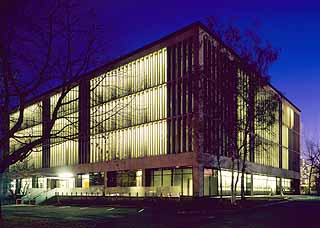
DJC.COM
March 3, 2005
New buildings bring science into the city
MBT Architecture

Photo courtesy of MBT Architecture
The University of Washington adapted the former Washington Natural Gas building for biotechnology research. Passersby can peer into the research spaces through its distinctive floor-to-ceiling windows.
|
From the days of the first settlers to the 21st-century technologies of Microsoft and Boeing, the Seattle area has a strong pioneering spirit. So it's no surprise to see that Seattle is now becoming one of the foremost centers for biotechnology research in the country.
As this industry develops, it is quietly leaving the university campuses and corporate greenfield sites and moving into the city itself. Today, as we walk through our city from Denny Way south towards Pioneer Square we pass a research building approximately every four blocks.
More than ever, the business of science is seeking a connection to Seattle's urban environment, one that promotes interaction with the community and sharing of Seattle's amenities. And with the move into the downtown core, science is becoming more visible to the community.
New buildings fit in
Since Zymogenetics' Lake Union Steam Plant headquarters, the first visible icon of the industry in the city, the latest additions to Seattle's growing scientific community interact with their neighbors in their own unique way.
The University of Washington's new medical research center in the former Washington Natural Gas headquarters (affectionately called the Blue Flame Building) is another example of adapting an urban building to house science.
For this first phase of a new off-campus research complex, developed by Vulcan Inc., the connection to the university, the emerging biotechnology campus of South Lake Union and the neighboring community were critical elements in the design. There is no doubt as to the building's new function. Floor-to-ceiling windows allow light to flood the interior laboratories while revealing research spaces to the passersby.
For the scientist this is a building that exerts a strong sense of place. There is a connection to the South Lake Union community from every floor of the building. Views encompass its neighbors — Fred Hutchinson Cancer Research Center, Merck/Rosetta and the University of Washington's Rosen Building, as well as the bustling thoroughfare of Mercer and the constant activity of the city in the background. This building is an active, living building whose transparency reveals what goes on inside.
The nearby Merck/Rosetta Building is more unassuming from the outside. It was designed as a speculative office building, fitting quietly into the context of its neighborhood, yet it exudes an air of welcome and invitation as it is approached.
An interactive "art wall" using dichroic glass fins that change color during the day was designed by Buster Simpson to engage pedestrians, and bring life to the streetscape. An outdoor pingpong table, also designed by Simpson, is adjacent to the street, and a cafe shared by Rosetta employees and the public also encourage interaction with the new facility, welcoming neighbors and creating a sense of community.
A biotech high-rise
Touchstone's new biotech building at 9th and Stewart, now home to Corixa's corporate headquarters, distinguishes itself as the first high-rise research building in the city. The exterior signals it is more than just another office building, with its prominent floor-by-floor intake louvers. At street level the lobby attracts urbanites with bright finishes and a glass orb fountain sculpture by local artist Joe MacDonald.
The rich colors and interactive nature of the lobby design quickly dispel the notion of science as a cold, clinical process performed by people in white coats. The scientists inside are also welcomed with a warm color palette and beautiful finishes, views from the labs maintain a continuous connection to the urban community of which they are a part. A roof terrace allows employees access to fresh air and the immediate experience of a downtown workplace.
This project was recently recognized by the design community with an honorable mention by the IIDA North Pacific Chapter. Jurors recognized it for its "timeless design" and "balanced use of color" and concluded that it is "designed as a lab should look — clean with just the right amount of color."
Demystifying science
It is easy to see the benefits of this symbiotic relationship between research buildings and city. Their presence is cause for celebration. It demystifies the science and brings important research into the heart of the community directly set to benefit from the results. For scientists, their new location is a constant reminder of the vitality of the world around them, a world they are striving to improve, and of the importance of their research to the health of the community surrounding them.
It is the architectural community's responsibility to design research buildings that enrich the urban environment and strengthen our neighborhoods while facilitating the best possible experience for the scientists within. Fulfilling this mission is key to our ability as a city and as a community to attract the best talent to our region and fuel our reputation as an hub for great biotech research.
Kay Kornovich is a principal with MBT Architecture whose work includes projects for Corixa, Merck and the recently completed ZymoGenetics Earl Davie Building expansion.
Other Stories:
- Building a foundation for biotech
- Can Seattle become a first-tier biotech hub?
- Laptops, Treos and phones! (Oh my!)
- Form follows function, even for biotech
- Build it right and they will come
- How one local developer took the biotech plunge
- 6 myths about building for biotech
Copyright ©2009 Seattle Daily Journal and DJC.COM.
Comments? Questions? Contact us.